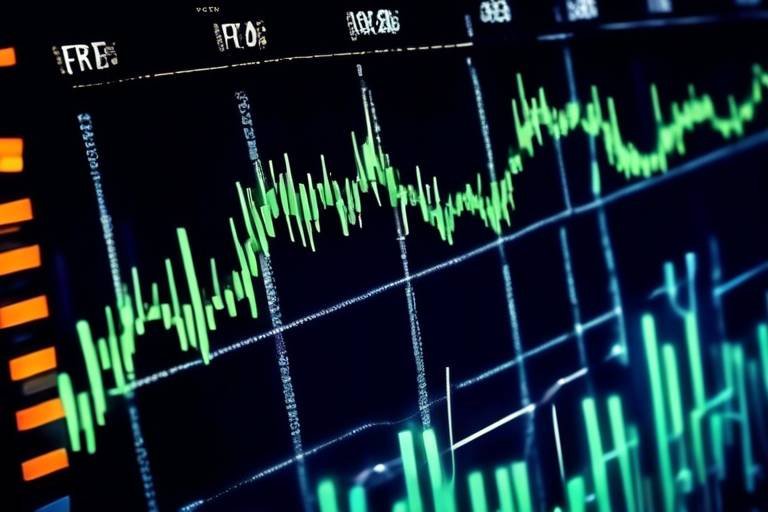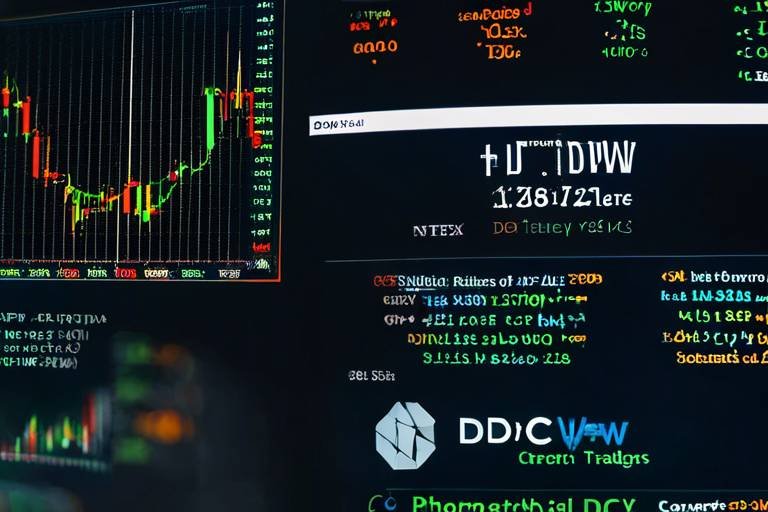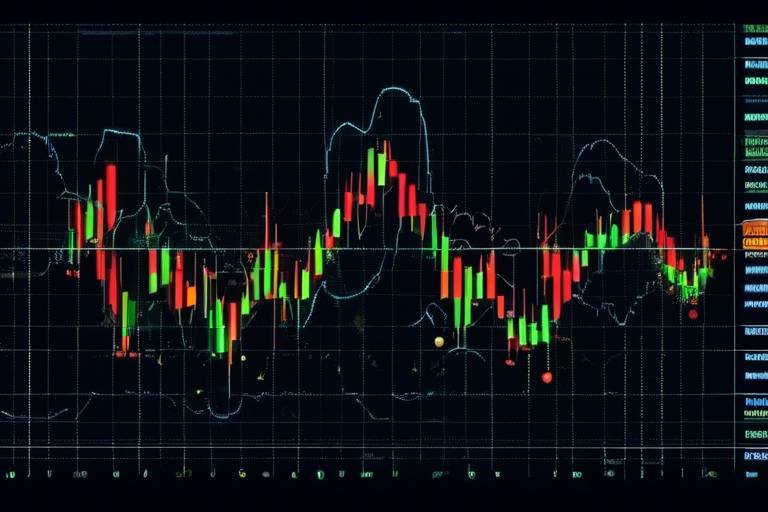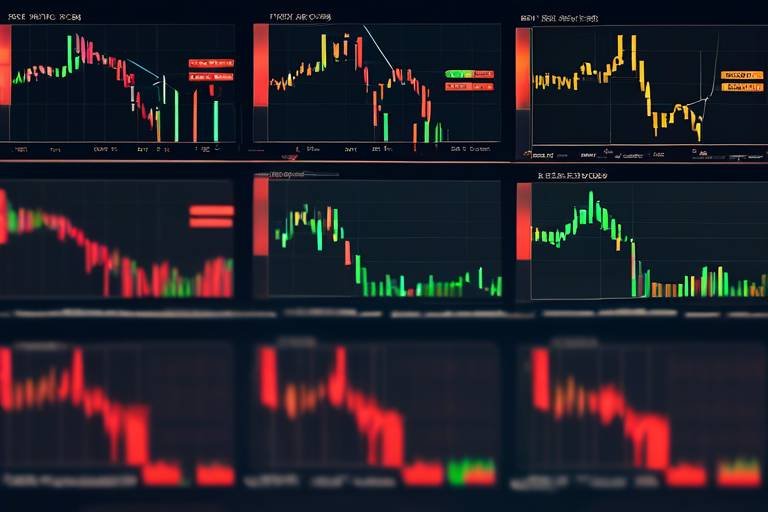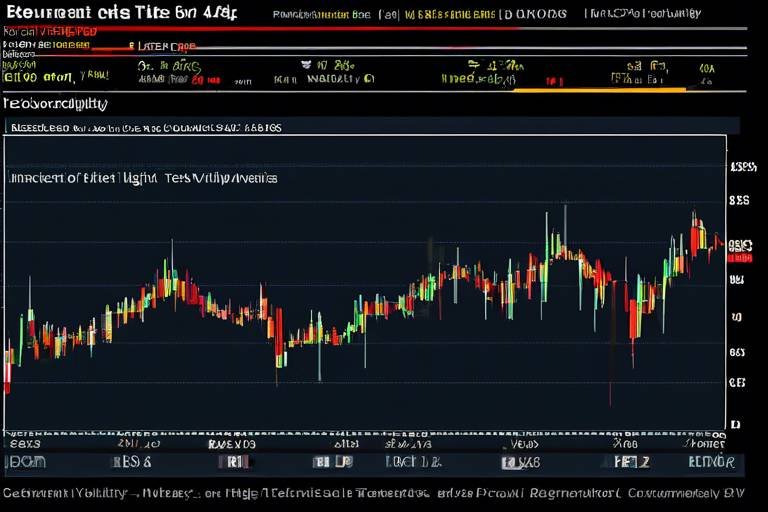How to Use Chart Indicators to Predict Price Movements
In the fast-paced world of trading, staying ahead of the curve is crucial. One of the most effective ways to do this is by utilizing chart indicators. These powerful tools can help you forecast price movements with greater accuracy, allowing you to make informed trading decisions. Imagine chart indicators as your trusty compass in the vast ocean of financial markets, guiding you through the turbulent waters of price fluctuations. By understanding how to leverage these indicators, you can enhance your trading strategies and potentially boost your profitability.
Chart indicators are essential tools in the realm of technical analysis. They provide traders with valuable insights into market trends and potential price movements. Think of them as the eyes of a hawk, giving you a clear view of what’s happening in the market. These indicators analyze historical price data and help traders identify patterns that may suggest future price behavior. By mastering these tools, you can better understand market dynamics and make more strategic decisions.
There are numerous chart indicators available, each serving different purposes. From trend-following indicators to momentum oscillators, understanding the various types can significantly enhance your trading toolkit. Here are some of the most commonly used indicators:
- Moving Averages: Used to identify trends by smoothing out price data.
- Relative Strength Index (RSI): A momentum oscillator that helps identify overbought or oversold conditions.
- Moving Average Convergence Divergence (MACD): A trend-following momentum indicator that shows the relationship between two moving averages.
Moving averages are one of the most popular indicators among traders. They work by smoothing out price data over a specific period, which helps in identifying trends. Imagine trying to read a book with a flickering light; it’s hard to see the story. Moving averages provide that steady light, making it easier to see the direction the market is heading. There are two primary types of moving averages: the Simple Moving Average (SMA) and the Exponential Moving Average (EMA).
The Simple Moving Average (SMA) is the most basic form of moving average. It calculates the average price over a specified number of periods. For instance, a 10-day SMA adds up the closing prices of the last ten days and divides it by ten. This simple calculation can help traders identify potential support and resistance levels. When the price is above the SMA, it suggests a bullish trend, while a price below the SMA indicates a bearish trend.
On the other hand, the Exponential Moving Average (EMA) gives more weight to recent prices, making it more responsive to new information. This characteristic makes the EMA particularly useful for identifying entry and exit points. Traders often prefer the EMA over the SMA because it can highlight trends more quickly. For example, if the EMA crosses above the SMA, it may signal a buying opportunity, while a crossover in the opposite direction could indicate a sell signal.
The Relative Strength Index (RSI) is another crucial indicator that traders use to gauge market momentum. It measures the speed and change of price movements on a scale of 0 to 100. An RSI above 70 typically indicates that an asset is overbought, while an RSI below 30 suggests it is oversold. Think of the RSI as a temperature gauge for the market—when it’s too hot, it might be time to cool off, and when it’s too cold, it could be time to warm up. By using the RSI, traders can identify potential reversals and make more informed decisions.
Using multiple indicators can provide a more comprehensive view of market conditions. Just like a chef uses various spices to create a delicious dish, combining indicators can enhance the flavor of your trading strategy. For instance, using the RSI with moving averages can help confirm trends and potential reversals. When both indicators align, it may signify a strong trading opportunity.
The confluence of indicators occurs when multiple indicators signal the same market direction. This alignment can create a powerful confirmation for traders. For example, if the RSI indicates an overbought condition while the price is nearing a resistance level indicated by the SMA, it might be wise to consider selling. Identifying these moments can lead to optimal trading opportunities and improved decision-making.
While chart indicators are valuable, they also have limitations. Relying solely on indicators without considering the broader market context can lead to poor decisions. Market sentiment, news events, and economic factors can all influence price movements in ways that indicators may not predict. Therefore, it’s essential to use indicators as part of a broader trading strategy that includes risk management and market analysis.
- What are chart indicators? Chart indicators are tools used in technical analysis to predict market trends and price movements.
- How do I choose the right indicators? The choice of indicators depends on your trading style and strategy. It’s often beneficial to combine different types of indicators for a more comprehensive analysis.
- Can I rely solely on chart indicators for trading? While chart indicators provide valuable insights, they should not be the only factor in your trading decisions. Always consider market context and other factors.

Understanding Chart Indicators
Chart indicators are essential tools in the world of trading, acting as the compass that guides traders through the often turbulent waters of financial markets. They provide invaluable insights into market trends and potential price movements, which can significantly enhance trading strategies. Imagine you're navigating a ship through foggy waters; without a compass, you might end up lost. Similarly, chart indicators help traders make informed decisions by illuminating the path ahead.
At their core, chart indicators analyze historical price data to forecast future movements. They come in various forms and serve different purposes, making them versatile tools for traders of all levels. Whether you’re a seasoned trader or just starting, understanding these indicators can be the difference between success and failure in the market. By interpreting the signals they provide, traders can identify trends, reversals, and potential entry and exit points.
One of the most exciting aspects of chart indicators is their ability to simplify complex market information. They transform raw data into visual representations that are easier to understand. For example, a moving average can smooth out price fluctuations, allowing traders to see the underlying trend more clearly. This simplification is akin to turning a dense forest into a clear path; it helps traders focus on what truly matters.
Moreover, chart indicators can be categorized into two main types: leading indicators and lagging indicators. Leading indicators are designed to predict future price movements, serving as early warning signals for potential market shifts. On the other hand, lagging indicators confirm trends after they have occurred, providing traders with a sense of security. Understanding the difference between these two types is crucial, as it helps traders choose the right tools for their specific strategies.
In the following sections, we will delve deeper into various types of chart indicators, such as moving averages, the Relative Strength Index (RSI), and the Moving Average Convergence Divergence (MACD), each offering unique insights into market dynamics. By mastering these tools, traders can enhance their decision-making process and improve their overall trading performance.

Types of Chart Indicators
When it comes to navigating the complex waters of financial markets, chart indicators are like a lighthouse guiding traders through the fog. These indicators serve as powerful tools that help traders make sense of price movements and market trends. Each type of indicator offers unique insights, allowing traders to tailor their strategies according to their trading style and objectives. In this section, we will explore some of the most commonly used chart indicators, including Moving Averages, Relative Strength Index (RSI), and Moving Average Convergence Divergence (MACD). Understanding these indicators can be the difference between a successful trade and a missed opportunity.
First up, we have the Moving Averages. This indicator is incredibly popular among traders for its simplicity and effectiveness. Moving averages help smooth out price data over a specific time frame, making it easier to identify the underlying trend. Traders typically use two types of moving averages: the Simple Moving Average (SMA) and the Exponential Moving Average (EMA). The SMA calculates the average price over a set period, while the EMA gives more weight to recent prices, making it more responsive to current market conditions.
Next, let's talk about the Relative Strength Index (RSI). This momentum oscillator is designed to measure the speed and change of price movements. By comparing the magnitude of recent gains to recent losses, the RSI provides valuable insights into whether an asset is overbought or oversold. Typically, an RSI above 70 indicates that an asset may be overbought, while an RSI below 30 suggests it may be oversold. This information can help traders make informed decisions about when to enter or exit trades.
Another vital tool in a trader's arsenal is the Moving Average Convergence Divergence (MACD). This indicator helps traders identify potential buy and sell signals by showing the relationship between two moving averages of an asset's price. The MACD consists of three components: the MACD line, the signal line, and the histogram. When the MACD line crosses above the signal line, it may indicate a bullish signal, while a cross below could suggest a bearish trend. Understanding how to interpret these signals can significantly enhance a trader's ability to predict price movements.
In addition to these primary indicators, traders can also explore other tools such as Bollinger Bands, Stochastic Oscillator, and Fibonacci Retracement levels. Each of these indicators offers a different perspective on market dynamics, and combining them can lead to more robust trading strategies. For example, using moving averages alongside the RSI can help confirm trends and identify potential reversal points.
Ultimately, the key to successful trading lies in understanding how to use these indicators effectively. By learning to read the signals they provide, traders can make more informed decisions and improve their chances of success in the ever-changing financial landscape.

Moving Averages
Moving averages are like the compass for traders navigating the often tumultuous seas of financial markets. They smooth out price data, allowing traders to identify trends over specific periods, which is crucial for making informed decisions. By averaging out past prices, moving averages help filter out the noise and focus on the underlying trend. Imagine you're trying to listen to a conversation in a crowded room; moving averages help you tune in to the most important voices, making it easier to understand where the market is headed.
There are two primary types of moving averages that traders commonly use: the Simple Moving Average (SMA) and the Exponential Moving Average (EMA). Each has its unique characteristics and applications, making them essential tools in a trader's arsenal. Understanding how to calculate and interpret these averages can significantly enhance your trading strategy.
The Simple Moving Average (SMA) is one of the most straightforward indicators. It calculates the average price of an asset over a specified number of periods, which can be days, weeks, or even months. For instance, a 10-day SMA adds up the closing prices of the last ten days and divides by ten. This average can smooth out price fluctuations, providing a clearer picture of the trend.
Traders often use the SMA to identify potential support and resistance levels. When the price is above the SMA, it may indicate an uptrend, while a price below the SMA could signal a downtrend. However, one must remember that the SMA is lagging; it reacts to price changes rather than predicts them. This characteristic means that it might not always provide timely signals for entry and exit points.
On the other hand, the Exponential Moving Average (EMA) gives more weight to recent prices, making it more responsive to new information. This feature can be particularly advantageous in fast-moving markets where timely decision-making is crucial. The EMA is calculated using a more complex formula that factors in the most recent price data more heavily than older data.
Traders often prefer the EMA over the SMA for its ability to signal potential entry and exit points more quickly. For example, when the EMA crosses above the SMA, it may indicate a bullish signal, suggesting that it might be a good time to buy. Conversely, when the EMA crosses below the SMA, it could signal a bearish trend, prompting traders to consider selling. This responsiveness makes the EMA a favorite among day traders and those looking to capitalize on short-term price movements.
In summary, moving averages are indispensable tools for traders. They not only help in identifying trends but also in determining potential entry and exit points. By understanding the differences between the SMA and EMA, traders can better tailor their strategies to fit their trading styles and market conditions.
- What is the main difference between SMA and EMA? The SMA gives equal weight to all prices in the selected period, while the EMA gives more weight to recent prices, making it more responsive to price changes.
- How can I use moving averages in my trading strategy? You can use moving averages to identify trends, support and resistance levels, and potential entry and exit points based on crossovers between different moving averages.
- Are moving averages suitable for all trading styles? While moving averages are versatile, they are particularly useful for trend-following strategies. However, they may not be as effective in ranging markets.

Simple Moving Average (SMA)
The is one of the most fundamental tools in the trader's toolkit. It provides a clear, straightforward method for identifying trends by averaging a set number of price points over a specified time frame. Imagine you're trying to see the forest for the trees; the SMA helps you step back and get a clearer view of the overall trend without the noise of daily price fluctuations. By smoothing out price data, the SMA allows traders to focus on the bigger picture, which is essential for making informed decisions.
To calculate the SMA, you simply add up the closing prices for a specific period and then divide that sum by the number of periods. For example, to calculate a 10-day SMA, you would add the closing prices for the last 10 days and divide by 10. This calculation can be done easily using spreadsheet software or trading platforms. Here’s a quick example:
| Day | Closing Price |
|---|---|
| 1 | $10 |
| 2 | $12 |
| 3 | $11 |
| 4 | $13 |
| 5 | $15 |
| 6 | $14 |
| 7 | $16 |
| 8 | $17 |
| 9 | $18 |
| 10 | $19 |
In this example, the SMA for the last 10 days would be calculated as follows:
SMA (10 + 12 + 11 + 13 + 15 + 14 + 16 + 17 + 18 + 19) / 10 $14.5
One of the primary benefits of using the SMA is its ability to act as a support or resistance level. When the price is above the SMA, it can indicate a bullish trend, while a price below the SMA may suggest a bearish trend. Traders often use the SMA to identify potential entry and exit points. For instance, if the price crosses above the SMA, it could signal a buying opportunity, while a cross below may indicate a sell signal.
However, like any tool, the SMA is not without its limitations. It is a lagging indicator, meaning it reacts to price changes rather than predicts them. This can lead to delayed signals, especially in volatile markets. Additionally, the choice of time period for the SMA can significantly affect its effectiveness. A shorter time period may react more quickly to price changes but can also generate false signals, while a longer period may provide more reliable signals but at the cost of timeliness.
In conclusion, the Simple Moving Average is a powerful yet simple tool for traders looking to understand market trends. By incorporating the SMA into your trading strategy, you can gain valuable insights into potential price movements, helping you to make more informed decisions. Just remember, while the SMA can guide you, it’s always wise to combine it with other indicators and market analysis for the best results.

Exponential Moving Average (EMA)
The is a powerful tool for traders seeking to gain an edge in the financial markets. Unlike the Simple Moving Average (SMA), which treats all data points equally, the EMA gives more weight to recent prices. This makes it particularly responsive to new information, allowing traders to identify trends more quickly. Imagine you’re trying to keep track of your favorite sports team’s performance; the latest games are more relevant to your assessment than those from last season, right? That’s the essence of the EMA—it helps you focus on what matters most in the moment.
To calculate the EMA, you can use the following formula:
EMA (Current Price x (k)) + (Previous EMA x (1 - k)) where k 2 / (N + 1)
In this formula, N represents the number of periods you want to analyze. For instance, if you're looking at a 10-day EMA, you would set N to 10. The k value helps determine the weight of the most recent price in the calculation. The beauty of this indicator lies in its ability to adapt to price changes, making it a favorite among day traders and swing traders alike.
One of the key advantages of the EMA is its ability to signal potential entry and exit points. When the price crosses above the EMA, it can indicate a buying opportunity, whereas a price drop below the EMA might suggest it's time to sell. This dynamic responsiveness makes the EMA particularly useful during volatile market conditions, where quick decisions can lead to significant gains or losses.
However, it’s essential to remember that no indicator is foolproof. The EMA can produce false signals, especially during sideways market conditions where prices fluctuate without a clear trend. Therefore, many traders opt to combine the EMA with other indicators for a more comprehensive analysis. For example, using the EMA alongside the Relative Strength Index (RSI) can help confirm whether a trend is gaining momentum or losing steam.
In summary, the Exponential Moving Average is an invaluable tool for traders looking to navigate the complexities of the market. By focusing on recent price movements, it allows for quicker reactions and more informed trading decisions. Just remember, while the EMA can guide you, it's always wise to consider the bigger picture and incorporate other indicators to enhance your trading strategy.
- What is the main difference between EMA and SMA?
The EMA gives more weight to recent prices, making it more responsive to new information compared to the SMA, which treats all prices equally. - How can I use EMA in my trading strategy?
You can use EMA to identify potential entry and exit points by observing price movements relative to the EMA line. - Can EMA be used in all types of markets?
Yes, while it is popular in forex and stock trading, EMA can be applied to any market where price data is available.

Relative Strength Index (RSI)
The is a powerful momentum oscillator that traders use to gauge the speed and change of price movements. Imagine you're trying to figure out whether a stock is too hot to handle or too cold to touch; that's where the RSI comes in! It ranges from 0 to 100 and helps traders identify overbought or oversold conditions in the market. Typically, an RSI above 70 indicates that a stock might be overbought, while an RSI below 30 suggests it could be oversold. But what does this really mean for your trading strategy?
To put it simply, the RSI helps you spot potential reversals in price trends. If you're looking at a stock that's been on a tear and suddenly hits an RSI of 75, you might start thinking about taking some profits. Conversely, if a stock has been beaten down and the RSI dips to 25, it could be a signal to consider buying. The beauty of the RSI lies in its ability to provide insights into market sentiment, helping you make more informed decisions.
Calculating the RSI involves a bit of math, but don’t worry; it's not as complicated as it sounds! The formula is:
RSI 100 - (100 / (1 + RS)) Where: RS Average Gain / Average Loss
To break it down further, you first calculate the average gains and average losses over a specified period, usually 14 days. Once you have these values, you can find the Relative Strength (RS) and plug it into the RSI formula. The result will give you a percentage that indicates whether the asset is overbought or oversold.
One of the most effective ways to use the RSI is to look for divergences. A divergence occurs when the price of an asset moves in the opposite direction of the RSI. For instance, if a stock is making new highs but the RSI is failing to reach new highs, this could be a sign of weakening momentum and a potential reversal. It's like hearing a car engine sputter while the car is still moving; something might be off!
However, just like every tool in your trading toolbox, the RSI is not foolproof. It’s essential to consider other factors and indicators before making any trading decisions. Relying solely on the RSI can lead to false signals, especially in strong trending markets where the RSI can remain overbought or oversold for extended periods. Thus, it’s wise to use the RSI in conjunction with other indicators for a more comprehensive analysis.
In summary, the RSI is a fantastic tool for understanding market momentum and identifying potential buy and sell signals. When used correctly, it can significantly enhance your trading strategy. Just remember to keep an eye on the overall market context and combine it with other indicators for the best results!
- What is the best period to use for the RSI? - The standard period is 14 days, but some traders prefer shorter or longer periods depending on their trading style.
- Can the RSI be used in all markets? - Yes, the RSI can be applied to stocks, forex, commodities, and cryptocurrencies.
- Is the RSI a leading or lagging indicator? - The RSI is considered a lagging indicator, as it is based on past price movements.

Combining Indicators for Better Insights
When it comes to trading, relying on a single chart indicator can be like trying to navigate a stormy sea with just one oar. Sure, it might get you somewhere, but it’s not the most effective way to reach your destination. By combining indicators, traders can gain a more comprehensive view of market conditions, enhancing their ability to predict price movements. This approach can act as a safety net, catching potential pitfalls that might be overlooked when using just one tool.
Imagine you’re trying to decipher a complex puzzle. Each chart indicator provides a piece of that puzzle, and when you combine them, you start to see the bigger picture. For instance, using the Relative Strength Index (RSI) alongside Moving Averages can give a clearer indication of whether a trend is strong or if it’s about to reverse. The RSI might tell you that a stock is overbought, while the moving averages could confirm that the trend is still intact. Together, these indicators can help you make more informed trading decisions.
One effective strategy is to look for the confluence of indicators. This occurs when multiple indicators signal the same market direction. For example, if both the RSI shows an overbought condition and the price is above the moving average, this could be a strong signal to consider taking profits or entering a short position. On the flip side, if the RSI indicates oversold conditions while the price is below the moving average, it might suggest a buying opportunity.
However, it’s crucial to remember that not all indicators are created equal. Some may work better in trending markets, while others might shine in sideways markets. Therefore, understanding the context in which you’re trading is essential. A combination of indicators can provide a more robust framework, but they should be tailored to fit the specific market conditions you’re facing.
Here’s a quick look at how some popular indicators can be combined:
| Indicator Combination | Purpose |
|---|---|
| RSI + Moving Average | Identifies potential reversals and confirms trends. |
| MACD + Bollinger Bands | Helps identify momentum and potential breakout points. |
| Stochastic Oscillator + Volume | Confirms the strength of price movements with volume trends. |
Ultimately, the goal of combining indicators is to filter out noise and enhance your decision-making process. Just like a well-tuned orchestra, each indicator plays its part, contributing to a harmonious trading strategy. It’s about finding the right balance and ensuring that your indicators complement each other rather than contradict. So next time you’re analyzing a chart, remember that the magic often happens when you bring multiple indicators into play.
- What are chart indicators? Chart indicators are tools used in technical analysis to help traders forecast price movements based on historical data.
- Can I rely solely on indicators for trading? While indicators are helpful, they should not be the only factor in your trading decisions. Always consider market context and other fundamental factors.
- How do I choose which indicators to combine? Consider your trading strategy and market conditions. Test different combinations to see which provide the best insights for your trading style.

Confluence of Indicators
The is a powerful concept in technical analysis that can significantly enhance your trading strategy. Imagine you’re a detective piecing together clues to solve a mystery; each indicator serves as a clue, and when multiple indicators point towards the same conclusion, it’s like finding the smoking gun. This alignment can provide traders with a stronger signal about market direction, increasing the likelihood of making a profitable trade.
When you see several indicators converging, it's time to pay attention. For instance, if both the Relative Strength Index (RSI) indicates that an asset is oversold and a Moving Average crossover signals a potential upward trend, the chances of a price reversal increase significantly. This convergence not only validates your trading decision but also provides a safety net against the inherent volatility of the markets.
To effectively identify confluence, traders often look for specific combinations of indicators. Here are a few popular combinations:
- RSI + Moving Averages: When the RSI shows overbought or oversold conditions and a moving average crossover occurs, it can signal a strong entry or exit point.
- MACD + Support/Resistance Levels: If the MACD line crosses above the signal line near a support level, it could indicate a strong buy signal.
- Bollinger Bands + Price Action: When the price touches the lower Bollinger Band while showing bullish candlestick patterns, it can suggest a potential reversal.
However, it's crucial to approach these signals with a critical eye. Not every confluence will lead to a successful trade, and false signals can occur. This is where risk management becomes essential. Always set stop-loss orders and consider the broader market context before making a trade. Remember, even the best indicators can fail, so a comprehensive analysis is key.
In summary, the confluence of indicators is like a symphony where each instrument plays its part to create a harmonious sound. When multiple indicators align, they can provide traders with a clearer picture of market dynamics, leading to more informed trading decisions. But, just like in music, it’s essential to recognize when to play loudly and when to hold back, ensuring that your trading strategy remains flexible and adaptive.
Q: What is the confluence of indicators?
A: The confluence of indicators refers to the situation where multiple technical indicators provide signals in the same direction, suggesting a higher probability of a price movement.
Q: How can I identify confluence in my trading?
A: Look for combinations of indicators that confirm each other, such as an RSI indicating overbought conditions along with a moving average crossover suggesting a potential price reversal.
Q: Are there risks involved in relying on confluence?
A: Yes, while confluence can enhance the likelihood of a successful trade, it’s important to use risk management techniques and consider the overall market context to avoid false signals.

Limitations of Chart Indicators
While chart indicators are powerful tools in a trader's arsenal, it's crucial to recognize their limitations. Relying solely on these indicators can lead to misguided decisions and potential losses. One of the primary drawbacks is that indicators are often based on historical data. This means they reflect past price movements rather than predicting future events. Think of it like trying to navigate a new city using an old map; it may give you some guidance, but it won't account for new roads or changes in traffic patterns.
Another significant limitation is that indicators can produce false signals. For instance, during volatile market conditions, indicators like the Relative Strength Index (RSI) or Moving Averages may indicate a trend reversal when the market is merely experiencing temporary fluctuations. This can lead traders to enter or exit positions prematurely, resulting in unnecessary losses. Hence, it's vital to interpret these signals with caution and not act on them blindly.
Moreover, chart indicators often work best in trending markets but can be less effective in sideways or consolidating markets. In such scenarios, indicators may generate conflicting signals, leaving traders confused. For example, a trader might see a bullish signal from the Moving Average, while the RSI indicates overbought conditions. This situation can create a dilemma, making it essential for traders to have a solid understanding of market context.
Additionally, relying too heavily on indicators can lead to analysis paralysis. With so many indicators available, traders can become overwhelmed by the data, leading to indecision. It's like standing in front of a buffet with too many delicious options; sometimes, having too many choices can hinder your ability to make a clear decision. Therefore, it's crucial to focus on a few key indicators that resonate with your trading style rather than trying to use them all.
Lastly, market conditions can change rapidly due to unexpected news events or economic shifts. Indicators do not account for these external factors, which can dramatically impact price movements. For instance, a sudden announcement regarding interest rates can lead to market volatility that no indicator could have predicted. This unpredictability emphasizes the importance of staying informed about global events and understanding how they can influence the markets.
In summary, while chart indicators can enhance trading strategies, they should not be the sole basis for decision-making. Traders must combine these tools with a solid understanding of market fundamentals, current events, and their own trading psychology. By doing so, they can navigate the complexities of the financial markets more effectively and make informed decisions that lead to success.
- What are chart indicators? Chart indicators are tools used in technical analysis to help traders identify trends and potential price movements based on historical data.
- Can I rely solely on chart indicators for trading? No, while they provide valuable insights, it's essential to consider market context and other factors to make informed decisions.
- What are some common chart indicators? Common indicators include Moving Averages, Relative Strength Index (RSI), and Moving Average Convergence Divergence (MACD).
- How can I improve my trading strategy using indicators? Combine multiple indicators, stay updated on market news, and understand the limitations of each tool to enhance your trading decisions.
Frequently Asked Questions
- What are chart indicators?
Chart indicators are tools used in technical analysis to help traders analyze price movements and market trends. They provide valuable insights that can aid in making informed trading decisions.
- How do moving averages work?
Moving averages smooth out price data over a specified period, allowing traders to identify trends more easily. They can be simple (SMA) or exponential (EMA), with EMAs giving more weight to recent prices.
- What is the Relative Strength Index (RSI)?
The RSI is a momentum oscillator that measures the speed and change of price movements. It helps traders identify overbought or oversold conditions, indicating potential reversal points in the market.
- Can I use multiple indicators at once?
Absolutely! Using multiple indicators can provide a more comprehensive view of market conditions. Traders often look for a confluence of indicators, where several signals align to confirm a market direction.
- What are the limitations of chart indicators?
While chart indicators are useful, they have limitations. They may lag behind price movements and can give false signals, especially in volatile markets. It's crucial to consider broader market context and not rely solely on indicators.
- How can I combine indicators effectively?
Combining indicators involves using different types, such as trend and momentum indicators, to validate signals. For instance, if both a moving average and RSI indicate a bullish trend, it may be a stronger signal to enter a trade.
- Are there any free resources to learn about chart indicators?
Yes! Many online platforms offer free tutorials and courses on technical analysis and chart indicators. Websites, YouTube channels, and trading forums are great places to start your learning journey.

